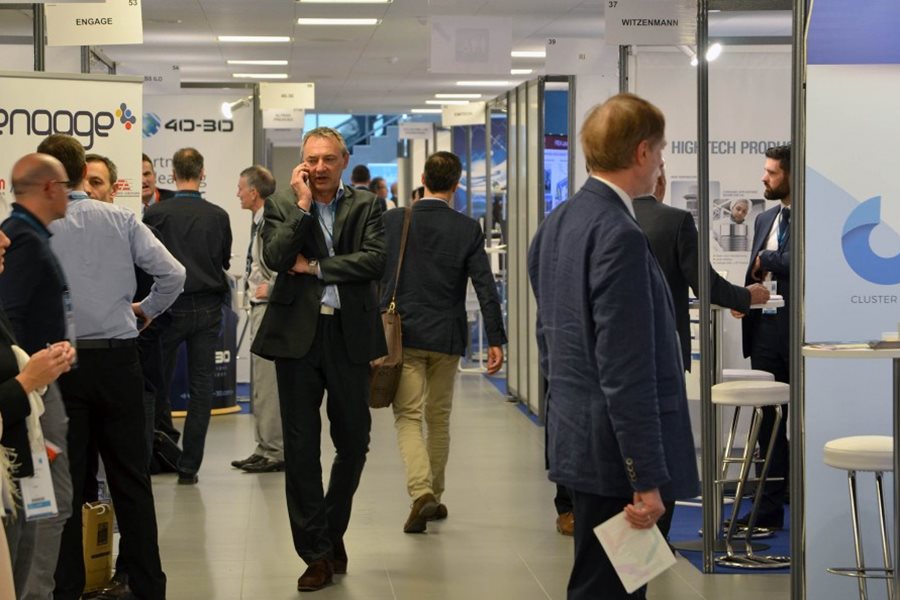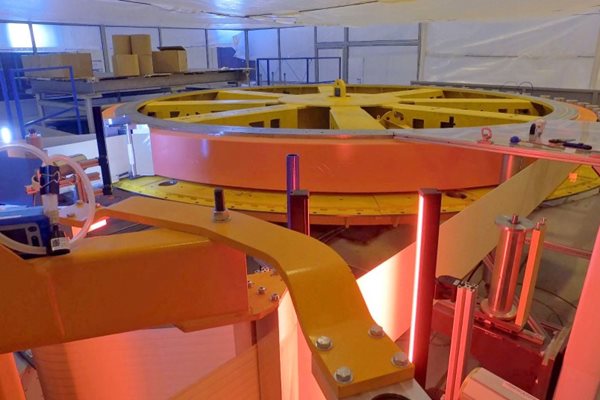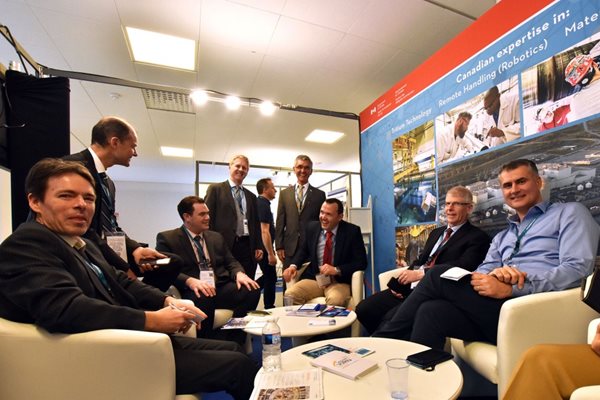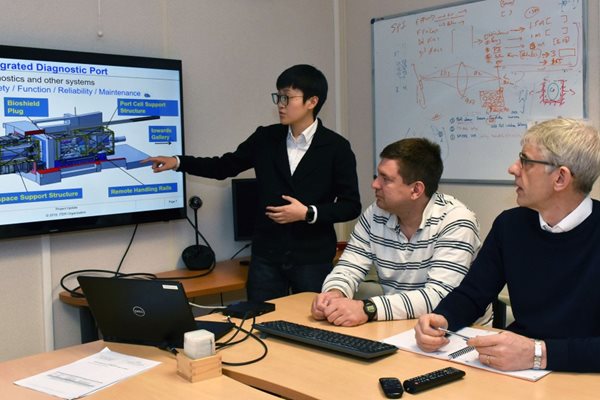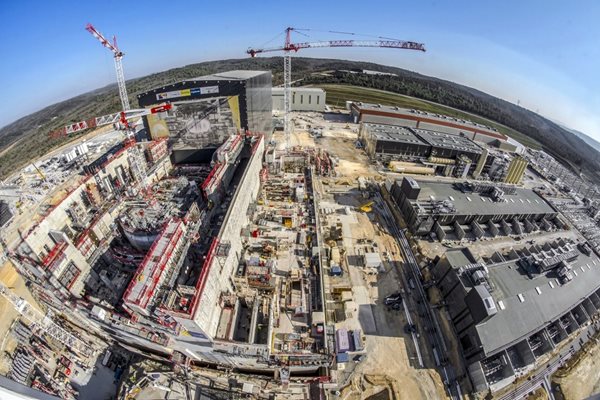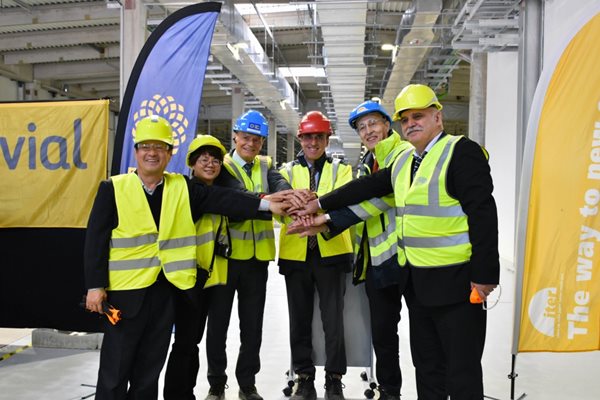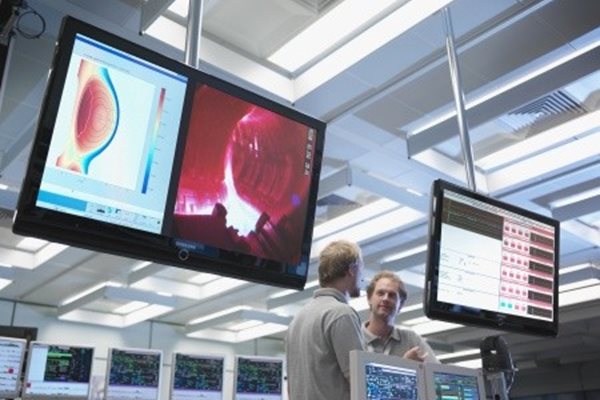
you're currently reading the news digest published from 25 Mar 2019 to 01 Apr 2019
featured6
of-interest1
press10
featured
IBF/19 | ITER and industry speak a common language
There is more to the French Riviera than sunny beaches, skimpy bathing suits, oversized yachts, and a world-class film festival. The stretch of coastline that extends from Saint Tropez to the Italian border also stands for scientific research and high technology. Located a few kilometres north of Antibes, Sophia Antipolis—a French equivalent of California's Silicon Valley—is home to more than 2,000 companies, most of them high-tech, and scores of laboratories, research institutes, public universities and engineering schools. Last week, as Sophia Antipolis celebrated the 50th anniversary of its creation, more than one thousand industry representatives gathered in nearby Antibes to meet with ITER stakeholders and hear updates on the project's progress, needs and upcoming tenders. Since its first edition in 2007 in Nice, France, the ITER Business Forum (IBF) has grown dramatically in scope and attendance. IBF/19, organized in Antibes on 27-28 March by Agence Iter France¹, was attended by the representatives of close to 500 companies and research institutes from 25 countries (1,110 people in all). The ever-increasing number of participants is not the only measure of success, however. What was palpable during the two days of presentations and business meetings was the intensity of the interactions—ITER and the world industry have now found a common language. 'When they see the pictures of worksite and manufacturing progress, industry representatives gets a clear message: ITER has now entered a very decisive phase and industry has a key role to play,' says ITER Divertor Section leader Frédéric Escourbiac, his pockets filled with the business cards collected during the two-day forum. 'What we have seen in the successive editions of IBF is a virtual community that has progressively acquired flesh and bone. The body is now strong and fit. We can talk face to face and it makes interaction much easier and much more productive.' As at all previous editions, IBF-19 began with a series of introductory presentations that highlighted progress accomplished and challenges to come. Following a general introduction by Jacques Vayron, the director of Agence Iter France, ITER Director-General Bernard Bigot compared ITER to an extremely complex Lego construction, saying that 'if one single piece, however small, is missing the whole project will suffer.' Gerassimos Thomas, the Deputy Director-General for Energy at the European Commission, acknowledged that, 'thanks to Director-General Bigot and with the help of the Domestic Agencies and all stakeholders, the project has dramatically turned around. [...] We now have an impeccable case to support ITER.' In a passionate demonstration of how ITER was 'making history,' ITER Chief Operating Officer and Deputy-Director General Gyung-Su Lee described the inevitable 'uncertainties and unknowns' of a first-of-a-kind machine but promised the audience that they would soon be 'listening to the beautiful sound of neutrons'—the heavenly music of fusion 'tamed and utilized to generate energy.' Representatives of each of the seven ITER Domestic Agencies took the stage in quick succession describing, sometimes with humour (and always with precision and conviction) the challenges faced and the accomplishments achieved. 'The future will be painted by you,' Gerassimos Thomas told the hundreds of industry representatives gathered in the amphitheatre on the first day of IBF-19. Through technical presentations, workshops and one-to-one meetings, it was soon clear that the 'future' was reaching far beyond ITER. 'We need to have as small a gap as possible between the end of ITER assembly and the engineering phase of DEMO,' stressed Tony Donné, Programme Manager for EUROfusion. 'Too large a gap would lead to the loss of industrial interest and expertise that is critical for the next-step machine and the future of fusion.' What IBF-19 demonstrated is that the relationship between ITER (and more broadly fusion) and industry has now reached a turning point. Beyond the experimental machine that is ITER, a whole new field of activity and innovation—encompassing hundreds of different technologies—is now opening before hundreds of companies throughout the world as the steps after ITER are being planned. And at the same time, the very role of industry is being redefined—graduating from 'supplier' to 'partner.' In Europe, dozens of companies are already involved in the conception of DEMO; in China 30 different entities, both industrial and academic, are at work on the China Fusion Engineering Test Reactor (CFETR)—a 'super ITER' that will evolve into a fusion reactor near-prototype, and whose engineering design is set to be completed in 2020. Since its relatively humble beginnings in 2007, the ITER Business Forum has been a key facilitator in this process. Click here to view a video walkthrough of IBF-19. ¹With the participation of ITER Organization, Fusion for Energy and other Domestic Agencies, and with the financial support of local authorities.
Europe | Fabrication begins on unique composite rings
After lengthy development, prototyping and test phases, the composite rings designed to help ITER's toroidal field coils cope with huge out-of-plane forces have been cleared for fabrication. In ITER, the electromagnetic interaction between the toroidal field coil current and the magnetic field generated by the poloidal field coils will create huge stresses on the toroidal field coils. Pre-compression rings will be installed at the top and bottom of the coil structures to 'push back' with a centripetal force of thousands of tonnes, suppressing any deflection and greatly reducing cyclic fatigue stresses. ITER's pre-compression rings are among the largest and most highly stressed composite structures to be designed for a cryogenic environment. Five metres in diameter, with a cross-section of 33.7 cm x 28.8 cm, the rings are made of a composite that consists of more than one billion minuscule glass fibres glued together using epoxy resin. Prototypes produced by European Domestic Agency contractor CNIM (Toulon, France) have responded well to the demanding tests underway since January, opening the way for fabrication to start on the first production unit. CNIM will manufacture nine pre-compression rings in all (three top, three bottom and three spare). CNIM has partnered with Exel Composites (Finland) for the raw material—a pultruded laminate delivered in lengths of 2.8 km (2 mm thick) on spools. Each laminate profile is wound into one ring on specialized winding tooling, with alternate layers of 0.12 mm-thick epoxy tape applied. The completed ring is cured and then machined to the required final dimensions. Winding started in late February and the first curing operations took place in March. All nine pre-compression rings are expected to be completed by mid-2020. See the full report on the European Domestic Agency website.
Canada | Exploring possibilities
Visitors to the industrial exhibition at the ITER Business Forum (IBF) last week were treated to an unusual sight at ITER: a display featuring Canadian nuclear companies. ITER history buffs will remember that Canadian industrialists and academics proposed a site for the ITER Project in Clarington, Ontario, only to withdraw their bid in 2003. But last year, hopes were rekindled when in April 2018 the ITER Director-General and the Canadian Minister of International Trade signed a Memorandum of Understanding agreeing to explore the possibility of future cooperation. As the IBF discussions demonstrated, Canadian industry is both versatile in its range of capabilities and keenly interested. Prior to arriving at IBF/19, the Canadian delegation visited the ITER site, where they met with Director-General Bernard Bigot and toured the ITER construction platform. As often happens during tours, the participants walked away visibly impressed. To quote Dean Townsend, the Vice President of Engineering Strategy for Ontario Power Generation (OPG): 'The scale and complexity of the facilities we visited were truly awe-inspiring, and demonstrated to us how the best engineering and construction talents of many nations can be harnessed to achieve monumental results.' The delegation itself came from multiple sectors: the group was coordinated by Ron Oberth of the Organization of Canadian Nuclear Industries and was rounded out by the Canadian Trade Commissioner in Paris, Denis Trottier in addition to OPG. Ten leading Canadian industrial suppliers participated, ranging from ATS Automation and Rolls-Royce Civil Nuclear Canada to Laker Energy Products and Tyne Engineering. Corporate specialties included tritium handling and recycling, remote handling and hot cell management, and complex project management. Canada's academic sector was represented by Jerry Hopwood, president of the University Network of Excellence in Nuclear Engineering. And the mission to ITER and IBF/19 was funded by Global Affairs Canada, the federal ministry that oversees foreign affairs. What happens next? As with any new country interested in participating in the ITER Project, such decisions rest exclusively with the ITER Council and require unanimous consent. Discussions so far remain at the exploratory stage. But the palpable enthusiasm of ITER's newest visitors suggests that motivation is strong to see whether Canada can once again become part of the world's most complex scientific endeavour.
ITER Project Associates | A boost to ITER's workforce
They come from every ITER Member and contribute to the ITER Project in many different areas. The ITER Project Associates are a new type of resource in the ITER workforce, particularly in the scientific and technical departments. Over 70 Associates have taken up their positions since 2016. Hu Xiaoyue is a young mechanical engineer from the Institute of Plasma Physics at the Chinese Academy of Sciences (ASIPP). Half a year ago, she moved to the south of France to take up her assignment as an ITER Project Associate (IPA) in the Port Plugs & Diagnostics Integration Division. Xiaoyue's field of expertise is computer model design. 'I use computer programs like CATIA to coordinate the complex integration of diagnostic systems into vacuum vessel ports,' she explains. The IPA program seeks to leverage qualified resources from the ITER Members through the placement of personnel from public or private home institutes at ITER for a maximum of four years. The Associates remain employed by their home institutions, while contributing expertise in a specific domain at ITER through a contract of association. Another goal of the program is the strengthening of relationships between ITER and the Domestic Agencies. Created by ITER Director-General Bernard Bigot in 2015, the program got off to a start at the end of 2016 with the arrival of the first four ITER Project Associates. Since then, their number has grown to over 70 and dedicated efforts are underway to increase their number to 120 by the end of the year. The Port Plugs & Diagnostics Integration Division hosts the largest number of Project Associates, earning Division head Michael Walsh the title of 'Champion of the IPA program.' All ITER Members are contributing diagnostics to the project and so for Walsh, the enhanced cooperation achieved through the ITER Project Associate program is priceless. Fully integrated into the Division's teams, the Associates add value very quickly. Like Xiaoyue, many of the Project Associates in the Division focus on the integration of more than one hundred diagnostic systems into the ports and the infrastructure of the machine itself. For Victor Udintsev, who runs the Common Port Plug Engineering Section and works with 18 ITER Project Associates, 'their work in design, analysis and maintenance is indispensable.' The Domestic Agencies also enjoy the benefits. 'When people come to work here they will see ITER in reality and feel the challenges we face every day,' Walsh says. This experience turns the Project Associates into ITER Ambassadors and an invaluable resource for their home institutes and companies when they return to share their experience. He hopes that, in the long term, many of the colleagues in the Domestic Agencies will join as ITER Project Associates. 'We want to keep a strong cooperation with the Domestic Agencies so we can built up the right operating team for ITER.' For more on the opportunity to become an ITER Project Associate, see this ITER webpage.
Worksite progress | Planning for the Crane Hall
The last time Newsline climbed to the top of the highest worksite crane to take in the view it was a frigid December evening. Three months have passed and although the changes do not strike the eye, they are real. Beginning this summer, the view will change dramatically. Pillars will rise, beams will be positioned at regular intervals and, for a while, the Tokamak Building and its trademark bioshield will be half-hidden by the steel lattice of the Crane Hall's walls and roof. At a later stage, the extension will be clad in inox like the rest of the ITER buildings. By then, the worksite will look like the 'artist renditions' we used to publish when ITER had yet to become a reality.
Construction | Three more buildings ready for equipment installation
The European Domestic Agency Fusion for Energy has handed over three more buildings to the ITER Organization. The construction of the buildings and technical infrastructure of the ITER scientific installation represents Europe's single largest procurement contribution to the ITER Project—a scope covering some 39 buildings and technical areas on the construction platform. As each building is completed, the ITER Organization officially takes over responsibility and can then proceed with the installation of systems and equipment. Following the transfer of the heat rejection zone on the northern corner of the platform in December, three buildings to the south of the Tokamak Complex have now changed hands: Twin magnet power conversion buildings—for equipment converting AC power from the pulsed power switchyard to DC current for the superconducting magnets. A smaller building in the reactive power compensators area of the switchyard—for the high voltage switching equipment and control room for reactive power compensation. 'The importance of these three buildings is more than just technical,' said ITER Director-General Bernard Bigot during the handover ceremony. 'They are strong symbols of the ITER international collaboration—the ONE ITER spirit that unites us all.' Four ITER members will be supplying the equipment to be installed: China (transformers and converters for magnet power conversion plus the reactive power compensation system), Korea (transformers and converters for magnet power conversion), Russia (busbars to deliver the power to the magnets), and India (component cooling water system loops). The handover ceremony on 29 March marked the culmination of more than five years of effort by Fusion for Energy in the construction of the buildings. Equipment installation activities by the ITER Organization are scheduled to last about one year.
of-interest
JET secures funding through 2020
Funding has been secured for the Joint European Tokamak (JET) through the end of 2020, providing welcome visibility to the world's largest operating fusion research facility in the context of uncertainty surrounding Brexit. The future of JET has been under discussion since 2017 as its work is covered by the Euratom Treaty, which the UK Government intends to leave as part of the process of leaving the European Union. The new contract signed last week between the UK and the European Commission provides reassurance for over 500 staff at JET, including many from outside the UK. It also means JET can conduct a series of vital fusion tests planned for 2020 that will serve as a 'dress rehearsal' for ITER. JET is operated by the UK Atomic Energy Authority at the Culham Centre for Fusion Energy (CCFE). Scientists from 28 European countries use it to conduct research into fusion energy through work coordinated by the EUROfusion consortium, which manages and funds European fusion research activities on behalf of Euratom. Ian Chapman, CEO of the UK Atomic Energy Authority, said: 'The extension to the contract is excellent news for both European Union and UK science. JET has been a shining example of scientific cooperation between European Union members, and this news means that these mutually beneficial collaborations will continue, allowing us to do essential experiments on the path to delivering fusion power.' Tony Donné, Programme Manager of EUROfusion, added: 'A heavy weight has been lifted off our shoulders. This is extraordinarily good news for EUROfusion and the European fusion community as a whole. We can now continue to work on the realization of fusion energy together with the indispensable experience of our British partner.' See the EUROfusion and CCFE websites for more on the funding news.
